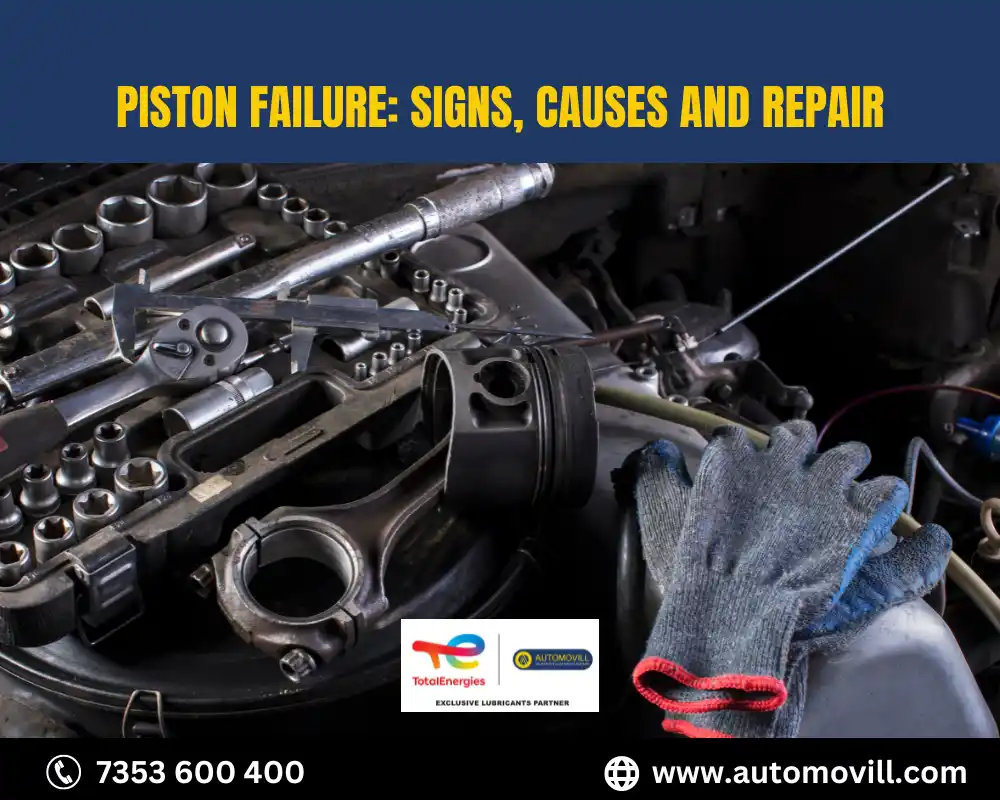
The piston is a critical component of the internal combustion engine. It is responsible for converting the pressure of the expanding gases into mechanical force that turns the crankshaft.
Piston failure can occur for a variety of reasons, and it can lead to complicated issues and heavy repair costs.
Let’s discuss piston failure signs, causes, repair process, and how to prevent it from happening again.
So, let’s rev up our engines and get started!
The function of the Piston
Before we get into the nitty-gritty of piston failure, let’s understand what a piston actually does in your car’s engine.
A piston is like a heavy metal plug that moves up and down inside a cylinder in your engine. It’s connected to the crankshaft, which is like the engine’s heart. When your car’s engine runs, the piston’s job is to move up and down inside the cylinder.
Here’s why it’s so important:
- Sucking in Air and Fuel: When the piston moves down, it creates a vacuum inside the cylinder. This vacuum helps to suck in air and fuel into the cylinder, which is necessary for the engine to create power.
- Compression: After it sucks in air and fuel, the piston moves back up. This compresses the air and fuel mixture, making it explode more powerfully when ignited.
- Power Stroke: When the air-fuel mixture is ignited, it creates a big explosion. This explosion pushes the piston back down with a lot of force. This is where the engine gets its power to turn the wheels and move your car.
- Exhaust Stroke: After the explosion, the piston goes back up again, but this time it pushes the burned gases out of the cylinder so the process can start all over again.
Signs of Piston Failure
Here we go:
1. Unusual Engine Noises
One of the first indicators of piston trouble is a series of strange noises coming from your engine. These may include knocking, tapping, or even a hissing sound. If your engine starts to sound more like a percussion ensemble than a well-tuned machine, it’s time to pay attention.
2. Loss of Power
If you notice a sudden loss of power when accelerating, it could be due to a piston failure. A healthy engine should provide consistent power, and any deviation from this norm should raise concerns.
3. Excessive Smoke
Keep an eye on your exhaust pipe. If you see billowing clouds of blue or gray smoke, it might be an indication of piston issues. This smoke is often a result of burning oil leaking into the combustion chamber.
4. Increased Oil Consumption
Piston damage can lead to increased oil consumption. If you find yourself constantly topping up your oil levels, it’s time to investigate further.
Causes of Piston Failure
1. Overheating
Overheating can cause the piston to expand beyond its limits, leading to scuffing or seizure. Ensure your cooling system is in good working order to prevent this.
2. Poor Lubrication:
Inadequate lubrication can cause excessive friction between the piston rings and the cylinder wall, resulting in damage over time. Regular oil changes and proper maintenance can help prevent this.
Detonation and Pre-ignition: These abnormal combustion events can exert excessive pressure on the piston, potentially causing it to crack or break.
Incorrect Timing: Timing issues, such as a misaligned timing belt or chain, can lead to the piston colliding with the valves, causing severe damage.
What Happens to Your Car When Piston Fails?
When a piston fails, it can have a domino effect on your car’s engine. The consequences can be severe and may include:
- Engine Stalling: A failed piston can cause your engine to stall, leaving you stranded and in need of a tow.
- Costly Repairs: Rebuilding or replacing an engine with a damaged piston can be an expensive endeavor, potentially costing thousands of dollars.
- Reduced Fuel Efficiency: A compromised piston can lead to decreased fuel efficiency, meaning you’ll spend more at the pump.
Repair Process
Repairing a piston failure is a complex and labor-intensive process. It typically involves:
- Engine Disassembly: The engine must be disassembled to access the damaged piston.
- Piston Replacement: The damaged piston is removed, and a new one is installed.
- Honing or Boring: The cylinder walls may need to be honed or bored to ensure a proper fit for the new piston.
- Reassembly and Testing: The engine is reassembled, and thorough testing is conducted to ensure it’s running smoothly.
Preventing Piston Failure
- Regular Maintenance: Follow your manufacturer’s recommended maintenance schedule, which includes oil changes, air filter replacements, and cooling system checks.
- Quality Fuel: Use high-quality fuel to prevent detonation and pre-ignition issues.
- Proper Driving Habits: Avoid aggressive driving, which can put unnecessary stress on your engine.
Conclusion
Protect your engine and your wallet by staying vigilant against the signs of piston failure and following proper maintenance practices.
If you suspect piston trouble, don’t delay; just chat or request a call back with us to consult a professional mechanic to address the issue before it becomes complicated.
Safe driving!
